Internal Marketing: Review for Next Generation Businesses
Service organizations face various issues and challenges. Berry (1981) has proposed the term Internal Marketing as a solution to multidisciplinary problems i.e. marketing, human resources and operations. This paper evaluates how different environmental settings have different interpretations of internal marketing. 70 research papers and reports, both quantitative and qualitative, have been analysed to fulfill the objectives of this research. This paper reviews the literature asserting concepts and constructs of internal marketing. It presents a discussion on the defining Internal Marketing (IM) objectives,theories and constructs that are relevant to the context of internal marketing. Finally a definition of internal marketing is proposed that can be useful for any service enterprise and moreover it can be utilised by any enterprise using and delivering service.
Introduction
More than 35 years ago, internal marketing was first proposed as a solution to the problem of delivering high service quality consistently by Berry, Hensel, & Burke, (1976). The internal marketing (IM) concept emerged from services marketing and its main concern was to get everyone who was involved in service encounters –the front line squad of contact workforce- to engage insuperior service delivery during interaction with customers(Kaurav & Prakash, 2011).
Since 1970s, IM has appeared to be a solution tothe problem related withconsistantly delivering high service quality (Berry, Hensel, & Burke, 1976). The literature dedicated to IM is rapidly evolving and increasing (Sasser & Arbeit, 1976; Berry, 1981; Gronroos, 1981; Richardson & Robinson, 1986; Barnes, 1989; George, 1990; Piercy & Morgan, 1990, 1991; Collins & Payne, 1991; Piercy, 1995; Foreman & Money, 1995; Varey, 1995; Cahill, 1995, 1996; Sergeant & Asif, 1998; Pitt & Foreman, 1999; Varey & Lewis, 1999; Ballantyne, 2000; Rafiq & Ahmed, 2000; Bansal, Mendelson, & Sharma, 2001; Ahmed & Rafiq, 2003; Ballantyne, 2003; Lings, 2004; Lings & Greenley, 2005; Panigyrakis & Theodoridis, 2009).The above authors have produced prominent research in the area of IM. In the following few paragraphs the concept of IM is explored.
Rationale for Study
Various researchers have identified that service enterprises are not achieving higher performances significantly as they should. Recent doctoral research has identified the concept of internal marketing as a solution to various issues and challenges such as interfunctional coordination and integration, quality of service delivery, satisfaction and employees empowerment.
The first important aspect related to this concept was it is equally accepted and practiced by various types of industries, i.e. banking, retail, finance, telecommunication, technology firms, hotel sector. The roles of services are been increasing in manufacturing industries also. Therefore the researchers decided to undertake further study to produce some insights about IM. This will increase the understanding of IM which can then be used by managers and planners, industry wide.
The second important dimension behind this initiative was when the researchersconducted research into Indian and Asian perspectives andfound that number of researches are very less in numbersin comparison of US and UK countries (as they are already developed countries). This was also an important reason why the researchers under took the decision to investigate further about internal marketing.
Methodology Utilised for Study
Researchers of this paper downloaded 1360 total research papers, with keywords such as internal marketing from different research databases, i.e. ebscohost, emerald insights, proquest, google scholar, and new economic papers. Subsequent filtering by the researchers resulted in 305 papers to analyse with the definitions and other analytical aspects of them. As a result of further analysis finally 70 papers, published during 1970 to 2013 were found suitable foranalysis on the basis of application orientation of the papers. These papers have been analysed for different dimensions, i.e., qualititative and quantitative perspectives.
The process commenced in September 2011 and was completed in January 2014.The researchers identified several definitions or models for applying the concept of IM in real world practices.
Defining Internal Marketing
Several researchers have attemptedto define internal marketing but their definitions have appeared to be extremely narrow and unclear in explaining concepts of IM.
Berry (1981) defined internal marketing as “Viewing employees as internal customers, viewing jobs as internal products and then endeavouring to offer products that satisfy the needs and wants of these internal customers while addressing the objectives of the organisation.”
In the same study he stated that the same marketing tools use to attract customers can also serve to attract and retain the best employees, who can be considered of as ‘internal customers’. For Berry it was only a tool to market to the internal customers for delivering satisfaction to external customers. He also used the tools of marketing for applying his idea.
Internal marketing acts as part of the marketing strategy with the employee’s themselves who are termed internal customers. It is used as a philosophy for managing the firm’s human resources based on marketing perspectives and practices to build internal competencies for external success or effective external marketing (George, 1990). It is a strategy that aims for the creation of high-performance work systems by managing the interdependent elements of the internal marketing concepts to achieve greater competencies for the firm. Consequently, these variables will influence a firm’s competitive advantage. George has recommended IM to increase internal competencies for decreasing threat of competition.
Thomson (1991) has elaborated IM while including “Looking at the employee as a valued customer is the focus of new descipline of internal marketing.”According to Thomson internal marketing is a means of creating values from inside (employees) and deliver it to outside (customers).
In the argumentive words of Mazure (1991), internal marketing is “Where you are thinking of your own employees as customers with needs to be satisfied so that they are enthusiastic – is that marketing’s job … or is it human resources?” Mazure advocates that IM is a concept which should belong to the human resource department and not with marketing people.
Berry & Parshuraman (1991)suggests interacting with frustrated and dissatisfied customers can deflate employees’ enthusiasm for the job, decrease their commitment, and result in increased employee turnover. Reichhled cited in Chowdhary & Prakash, (2005)Sr. Consultant, PiRockes Services Consultancy and author of The Loyalty Effect expresses his view for internal marketing in some other words – “Employee retention has a direct link to customer retention and acquisition.”The above authors have supported that the concept of IM should be practiced by HR people not by marketingas it is also is a way to solve the issues of HR.
• Lambert (1995) was of an opinion that a number of current management issues merit attention and can be treated with a broadened concept of internal marketing:
• retention of skilled people in an organisation by providing corporate and personal direction;
• relationship with the management team who share the objectives, experience and skills to build, release and mobilise individual motivation for economic recovery;
• building a corporate brand which appeals to both customers and organisation members; and
• productivity through participation requiring leadership, processes and commitment from all.
In a study of two hotels Owen & Teare (1996) concluded “If staff is happy about their organisation and the need to do in order to satisfy customers and are well trained and supported, they will, on average remain with their employer 3-4 times longer than employees who feel less secure.”
Rafiq & Ahmed (1998) expanded the idea of internal marketing and definedit as, “…a planned effort using a marketing-like approach to overcome organisational resistance to change and to align, motivate and inter-functionally coordinate and integrate employees towards the effective implementation of corporate and functional strategies in order to deliver customer satisfaction through a process of creating motivated and customer oriented employees”.
According to Woodruffe (1999) internal marketing can be defined as “Treating with equal importance the need of the internal market – the employees – and the external market through proactive programmes and planning to bring about desired organizational objectives by delivering both employees and customer satisfactions.”
Barnes & Morris, (2000); Bansal, Mendelson, & Sharma, (2001) also supported in similar words “Internal marketing can improve the organizational commitment and job satisfaction and when employee job satisfaction is enhanced, employees adopt a positive attitude when serving external customers, a state that can help to enhance customer loyalty.”
The concept of IM is that employees of the organisation are its first market. Some researchers have also stated that concept of internal marketing is based on the idea of employees as customers. Among the first who advocated the idea of IM were Sasser, (1976) and De Bussy, Ewing, & Pitt, (2003) who argued for the concepts given earlier and stated that the concepts of internal marketing are not limited to the ‘front-line’ customer service staff alone. Even the employees who do not interact directly with customers may impact upon percieved service quality because they directly influence the service providers. If all employees perform their jobs well they are counted as value-added components of the service and product offering.
Chowdhary & Prakash(2005) explained internal marketing as“Internal marketing refers to selling the service concept to the internal audience before it can be sold externally. The organization must ensure all support and enable the employees to deliver what is promised.”
Clow & Kurtz (2008) also defined internal marketing as “the process of using marketing concepts to enhance the satisfaction of company’s employees is called internal marketing.”
Evidences of Empirical Researches Related to Internal Marketing
Table 1 shows how different researchers have quantified or developed quantitative works for converting internal marketing concepts to operational words. This table also produces a related literature review of internal marketing in different services’ settings with a chronological development of the IM concept.

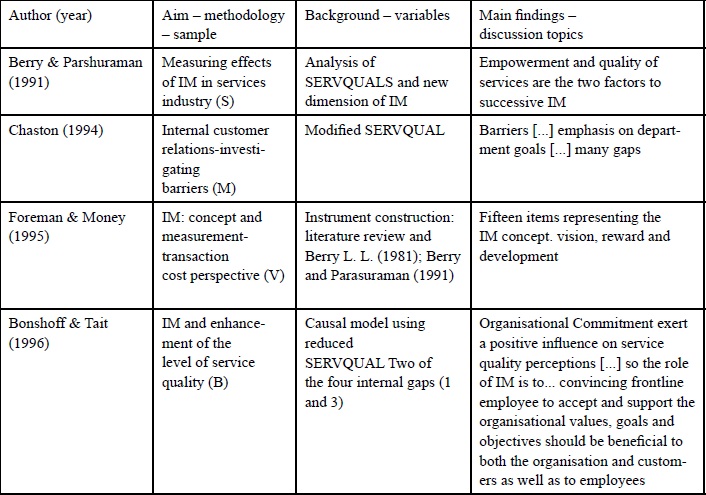
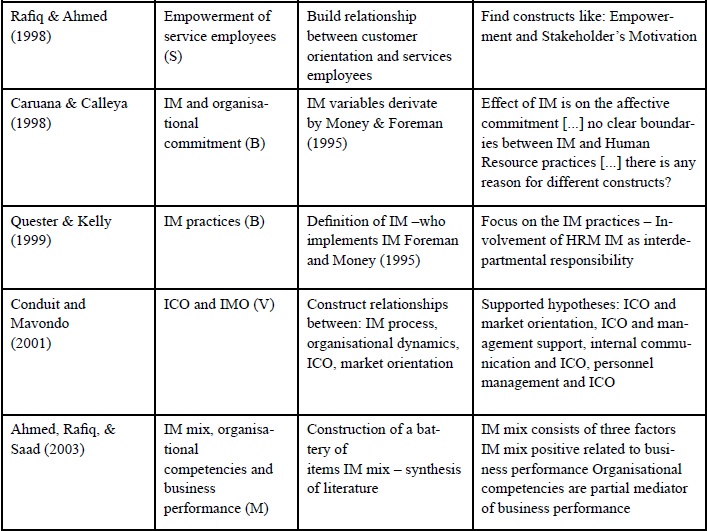
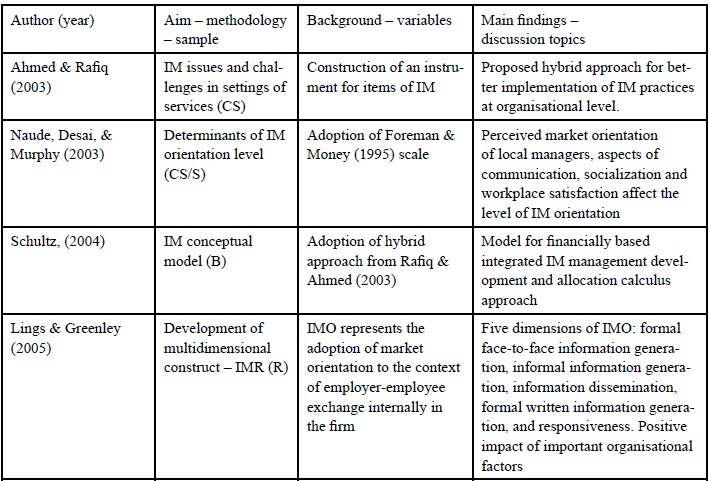

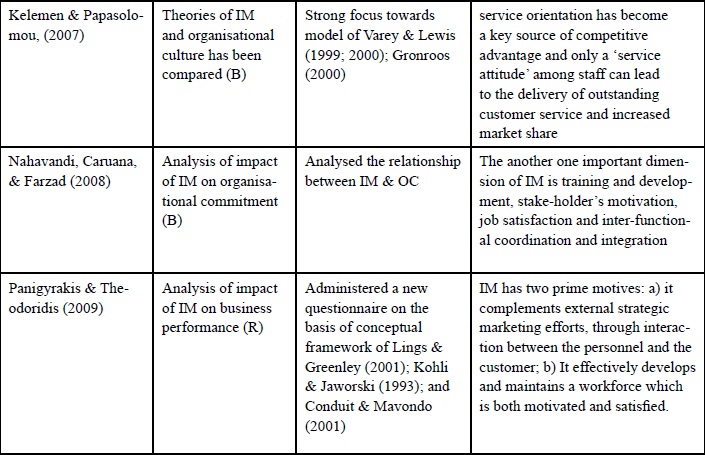
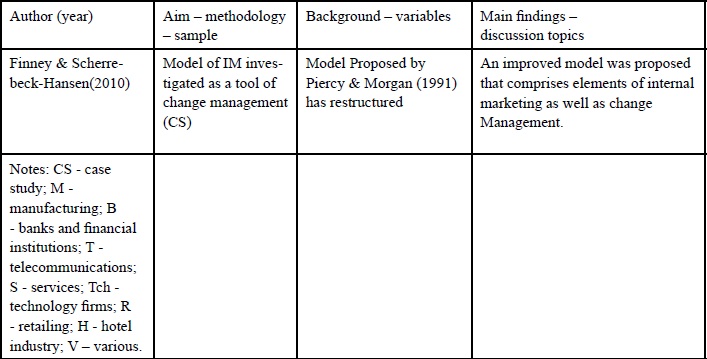
Geographical presence of researches of IM
Figure 1 presents the actual locations of various research studies done in context of internal marketing. This information is based on the availability of papers on online databases. The marked studies are full available papers and published in double blind refereed journals.

Major Disciplines of Internal Marketing
The definitions of internal marketing diverge to the great extent. The literature analysis reveals that it is possible to organize them according to their dominant perspective in the following major groups- i) IM as asynonym of HRM; ii) IM as a usage of marketing techniques in the internal market place; iii) IM as a precondition of satisfied internal customers; and iv) IM as a source of competitive advantage (Sincic & Vokic, 2007). The representatives of each group and their definitions are given in Table 2.
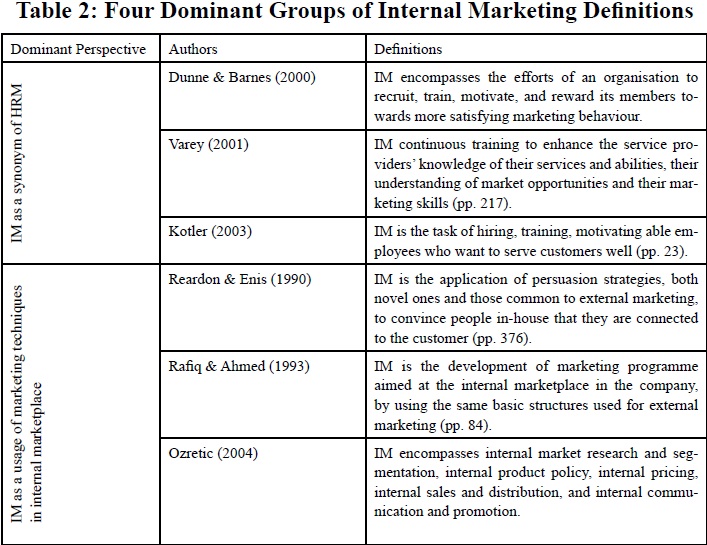

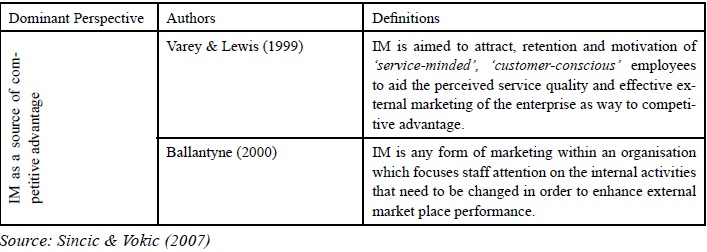
Outlining Objectives and Activities of Internal Marketing
Many researchers have discussed aspects about objectives and activities of internal marketing. This research has attempted to identify some of these different objectives and activities reflecting the various researcher opinions identified and presented in table 3.
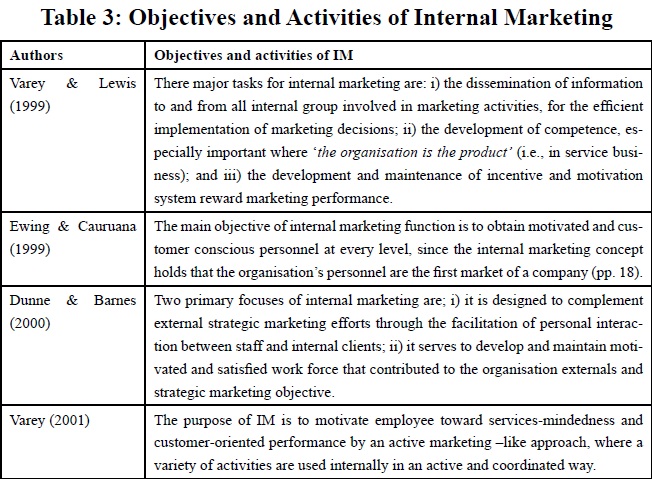
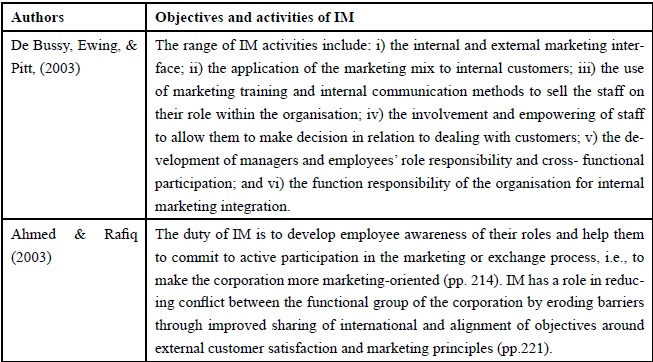
Constructs and Variables of Internal Marketing
From the many and varied literature reviews identified,13 constructs have been derived to make up the core structure of internal marketing for research. The constructs are i)inter-functional coordination and integration, ii) customer orientation, iii) marketing-like approach, iv) job satisfaction, v) empowerment, vi) stake-holder’s motivation, vii) quality of service, viii) stake-holder’s development, ix) vision of the firm, x) strategic rewards, xi) internal communication, xii) senior leadership, and xiii) training and development. For understanding and differentiating the above mentioned constructs, further discussions are followed here:
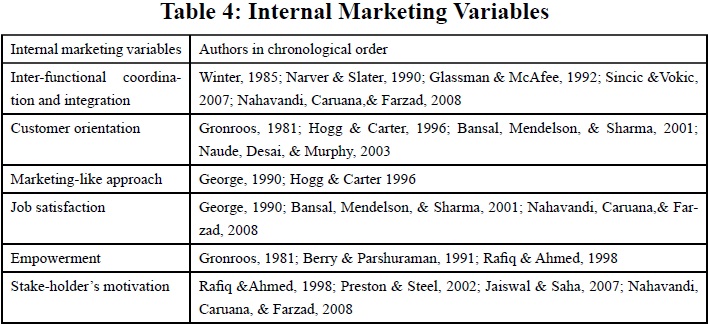
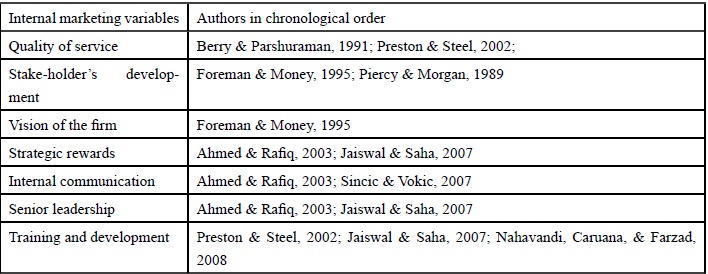
Conclusion
The concept of internal marketing is proposed to be a solution to many challenges of the next generation of businesses. The leaders have to convert the theories of IM into the practices of HRM department to assist in solving issues in marketing, human resources, operations and competitive advantages. The essence of this research is to define IM: Internal marketing is a practice for making internal customers (employees) happy to delight external customers (actual customers). To create a WOW effect in the minds of customers, employees should be in WOW motion at the time of delivering service. Managers need to adopt IM as strategic tool for satisfying three major dimensions of organisation as it can be a positive solution of problems related to – marketing, human resources and operations.
References
Ahmed, P.K., and Rafiq, M. (2003) ‘Internal marketing issues and challenges’, European Journal of Marketing, 37:9, pp. 1177-1188.
Ahmed, P. K., Rafiq, M. and Saad, N. (2003) ‘Internal marketing and the mediating role of organizational competencies’, European Journal of Marketing, 37:9, pp. 1221-1241.
Ballantyne, D. (2000) ‘The strengths and weaknesses of internal marketing’ in Varey, R. and Lewis, B. Internal Marketing: Directions for Management. London: Routledge, pp. 43-60.
Ballantyne, D. (2003) ‘A relationship-mediated theory of internal marketing’, European Journal of Marketing, 37:9, pp. 1242-1260.
Bansal, H.S., Mendelson, M. B., and Sharma, B. (2001) ‘The impact of internal marketing activities on external marketing outcomes’, Journal of Quality Management, 6:1, pp. 61-76.
Barnes, J.G. (1989) ‘The role if internal marketing: If the staff won’t buy it, why should the customer?’, Irish Marketing Review, 4:2, pp. 11-21.
Barnes, J.G., and Morris, D.S. (2000) ‘Revising quality awareness through internal marketing: An exploratory study amog French and English medium-sized enterprises’, Total Quality Management, 11:1, pp. 473-483.
Berry, L.L. (1981) ‘The employee as customer’, Journal of Retail Banking, 3:1, pp. 25-80.
Berry, L.L., and Parshuraman, A. (1991)Marketing Services: Competing Through Time, New York, Free Press.
Berry, L.L., Hensel, J., and Burke, M. (1976) ‘Improving retailer capability for effective consumerism response’, Journal of retailing, 52:3, pp. 25-80.
Bonshoff, C., and Tait, M. (1996) ‘Quality perception in the financial service sector: The potential impact of internal marketing’,International Journal of Service Industry Management, 7:5, pp. 5-31.
Cahill, D.J. (1995) ‘The managerial implications of the learning organizations: A new tool for internal marketing’,Journal of Services Marketing, 9:4, pp. 43-51.
Cahill, D.J. (1996) Internal Marketing: Your Company’s Next Stage of Growth, New York, The Haworth Press.
Caruana, A., and Calleya, P. (1998)‘The effect of internal marketing on organizational commitment among retail bank managers’, International Journal of Bank Marketing, 16:3, pp. 108-116.
Chaston, I. (1994) ‘Internal customer management and service gaps within the UK manufacturing sector’, International Journal of Operations and Production, 14:9, pp. 45-56.
Chowdhary, N., and Prakash, M. (2005) Textbook of Marketing of Services: The Indian Experience, India, Macmillan India Ltd.
Clow, K.E., and Kurtz, D.L. (2008) Services Marketing: Operation, Management, and Strategy (2ndedn), India, Biztantra.
Collins, B., and Payne, A. (1991) ‘Internal marketing a new perspective for HRM’,European Management Journal, 9:3, pp. 261-270.
Conduit, J., and Mavondo, F.T. (2001) ‘How critical id internal customer orientation to market orientation?’, Journal of Business research, 51:1, pp. 11-24.
De Bussy, N.M., Ewing, M.T., and Pitt, L.F. (2003) ‘Stakeholder theory and internal marketing communications: A framework for analyzing the influence of new media’, Journal of Marketing Communication, 9:3, pp. 147-161.
Dunne, P.A., and Barnes, J.G. (2000) ‘Internal marketing-A relationship and value creation view’In Varey, R.J. and Lewis, B.R. (eds), Internal Marketing: Directions for Management, London, Routledge, pp. 192-222.
Ewing, M., and Caruana, A. (1999). ‘An internal marketing approach to public sector management’, The International Journal of Public Sector Management, 12:1, pp. 17-29
Finney, S., and Scherrebeck-Hansen, M. (2010)‘Internal marketing as a change management tool: A case study in re-branding’, Journal of Marketing Communications, 16:5, pp. 325-344.
Foreman, S., and Money, A. (1995) ‘Internal marketing: Concepts, measurement and application’,Journal of Marketing Management, 11:8, pp. 755-768.
George, W. (1990)‘Internal marketing and organisational behaviour: A partnership in developing conscious employees at every level’,Journal of Business Research, 20:1, pp. 63-70.
Glassman, M., and Mcafee, B. (1992)‘Integrating the personnel and marketing functions’,Business Horizons, 35:3, pp. 52-59.
Gounaris, S.P. (2006) ‘Internal-market orientation and its measurement’, Journal of Business Research, 59:4, pp. 432-448.
Gronroos, C. (1981) ‘Internal marketing theory and practice’,American Marketing Association’s 7th Services Conference Proceedings, pp. 41-47.
Hogg, G., and Carter, S. (1996) ‘Employee attitudes and responses to internal marketing’, In Varey, R.J. and Lewis, B.R. (eds) Internal Marketing: Directions for Management, London, Routledge, pp. 109-124.
Jaiswal, K., and Saha, D. (2007) ‘Internal marketing – Case studies’, Indian Journal of Marketing, 37:12, pp. 28-34.
Kaurav, R.P.S., and Prakash, M. (2011) ‘Internal marketing – A gizmo to bind employees’ power in tourism enterprises’, South Asian Journal of Tourism and Heritage, 4:2, pp. 173-183.
Kelemen, M., and Papasolomou, I. (2007) ‘Internal marketing: A qualitative study of culture change in the UK banking sector’, Journal of Marketing Management, 23:7-8, pp. 745-767.
Kotler, P. (2003) Marketing Management (11thedn), Upper Saddle River, New Jersey, Pearson Education. Lambert, A. (1995) Company Brochure: People in Business, London.
Lings, N.I. (2004) ‘Internal market orientation: Construct and consequences’, Journal of Business Research, 57:4, pp. 405-413.
Lings, N.I., and Greenley, G.E. (2005) ‘Measuring internal market orientation’, Journal of Service Research, 7:3, pp. 290-305.
Mazure, L. (1991) ‘Silent satisfaction’, Marketing Business, 2:1, pp. 24-27. Nahavandi, N., Caruana, A., and Farzad, A. (2008) ‘The effect of internal marketing on organizatinal commitment in Iranian banks’, American Journal of Applied Sciences, 5:11, pp. 1480-1486.
Narver, J.C., and Slater, S.F. (1990) ‘The effect of market orientation on business profitability’, Journal of Marketing, 54:5, pp. 20-35.
Naude, P., Desai, J., and Murphy, J. (2003) ‘Identifying the determinants of internal marketing orientation’, European Journal of Marketing, 37:9, pp.1205-1220.
Owen, D., and Teare, R. (1996) ‘Driving top-line profitability through the management of human resources’,In Kotas, R., Teare, R., Logie, J., Jaywardena, C. and Bowen, J. (eds), The International Hospitality Business, London, Cassel, pp. 186-190.
Ozretic, D.D. (2004) ‘Interni marketing (Internal marketing)’, In Previsic, J. and Ozretic, D. D. (eds), Marketing, Zagreb, Adverta, pp. 47-94.
Panigyrakis, G.G., and Theodoridis, P.K. (2009)‘Internal marketing impact on business performance in a retail context’,International Journal of Retail and Distribution Management, 37:7, pp. 600-628.
Piercy, N. (1995) ‘Customer satisfaction and the internal market: Marketing our customers to our employees’, Journal of Marketing Practice and Applied Marketing Science, 1:1, pp. 22-44.
Piercy, N., and Morgan, N. (1990) ‘Internal marketing: Making marketing happen’, Marketing Intelligence and Planning, 8:1, pp. 4-6.
Piercy, N., and Morgan, N. (1991) ‘Internal marketing the missing half of the marketing programme’, Long Range Planning, 24:2, pp. 82-93.
Pitt, L.F., and Foreman, S.K. (1999)‘Internal marketing role in organisations: A transaction cost perspective’, Journal of Business Research, 44:1, pp. 25-36.
Preston, J.B., and Steel, L. (2002) ‘Employees, customers, and internal marketing strategies in LIS’, Library Management, 23:8/9, pp. 384-393.
Quester, P.G., and Kelly, A. (1999) ‘Internal marketing practices in theAustralian financial sector: An exploratory study’, Journal of Applied Management Studies, 8:2, pp. 217-229.
Rafiq, M., and Ahmed, P. (1998) ‘A customer-oriented framework for empowering service employees’, Journal of Services Marketing, 12:5, pp. 379-396.
Rafiq, M., and Ahmed, P. (2000) ‘Advances in the internal marketing concept: Definition, synthesis and extension’, Journal of Services Marketing, 14:6, pp. 449-462.
Rafiq, M., and Ahmed, P.K. (1993) ‘The scope of internal marketing: Defining the boundary between marketing and human resource management’, Journal of Marketing Management, 9:3, pp. 219-232.
Reardon, K.K., and Enis, B. (1990) ‘Establishing a company wide customer orientation through persuasive internal marketing’, Management Communication Quarterly, 3:3, pp. 376-387.
Richardson, B.A., and Robinson, G.C. (1986) ‘The impact of internal marketing on customer service in retail bank’, International Journal of Bank Marketing, 4:5, pp. 3-30.
Sasser, W.E., and Arbeit, S.P. (1976) ‘Selling jobs in the service sector’, Business Horizones, 19:3, pp. 61-65.
Schultz, D.E. (2004) ‘Building an internal marketing management calculus’, Interactive Marketing, 6:2, pp. 111-129.
Sergeant, A., and Asif, A. (1998) ‘The strategic application of internal marketing – An investigation of UK banking’, International Journal of Bank Marketing, 16:2, pp. 66-79.
Sincic, D., and Vokic, N.P. (2007) ‘Integrating internal communications, human resource management and marketing concepts into the new internal marketing philosophy’Working Paper Series – Faculty of Economics and Business: University of Zagreb, 07:12, pp. 4-13.
Thomson, K. (1991)‘Internally yours…’,Marketing Business,3:9, pp. 24-27.
Varey, R.J., and Lewis, R.B. (1999)‘A broadened conception of internal marketing’, European Journal of Marketing, 12:1, pp. 40-63.
Varey, R.J. (1995) ‘Internal marketing: A review and some interdisciplinary research challenges’, International Journal of Service Industry Management, 6:1, pp. 40-63.
Winter, J.P. (1985) ‘Getting your house in order with internal marketing: A marketing prerequisite’, Health Marketing Quarterly, 3:1, pp. 69-77.
Woodruffe, H. (1999) Services Marketing,India, Macmillan India Limited.
Dr. Rahul Pratap Singh Kaurav, Assistant Professor, Prestige Institute of Management, Gwalior, India. Email: rsinghkaurav@yahoo.co.in.
Dr. Monika Prakash, Associate Professor, Indian Institute of Tourism and Travel Management, Noida, India.
Dr. Nimit Chowdhary, Professor, Indian Institute of Tourism and Travel Management, Noida, India.
Alan David Briggs, Lecturer, Murdoch University, Murdoch, Western Australia.



